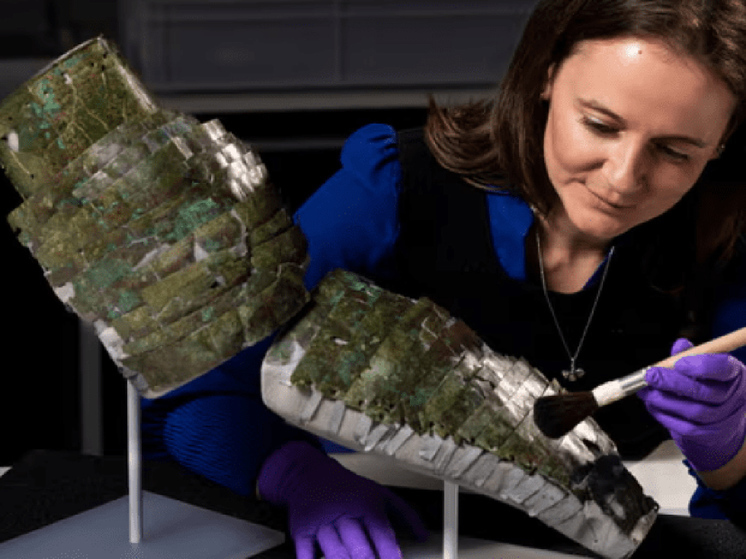A warrior's armlet was recreated for an exhibition about the life of the army of the ancient empire
A rare example of Roman armor from the collection of the National Museums of Scotland was reconstructed from dozens of fragments. The bronze armlet, dating from the mid-second century, will be shown for the first time in almost 2 thousand years at the exhibition “Legion: Life in the Roman Army” in February 2024.
 Photo: National Museums Scotland
Photo: National Museums Scotland
Restorers in Edinburgh have spent weeks restoring the bronze armlet, which is the most intact example of surviving Roman ammunition and one of only three known throughout the ancient empire. The armor was discovered in 100 fragments at the site of Fort Trimontium in 1906. The armlet is said to be in remarkably good condition, with remnants of the leather straps still attached to the metal.
Fraser Hunter, chief curator of prehistoric and Roman archeology at National Museums Scotland, said:
– This is an incredibly rare object and it's great that this exhibition has given us the opportunity to restore it. The transformation is amazing. Now that it has been restored, you can imagine the legionnaire who once wore it. It was both protection and status symbol — the bronze was expensive and shone like the gold on his sword hilt. This shows a clear connection with that important period when Scotland was on the northern frontier of the Roman Empire…
The fragments have been in the collection of the National Museums of Scotland for over a hundred years. The upper part of the armlet was on display at the National Museum of Scotland for 25 years, the lower part was given to the Trimontium Museum, and dozens of fragments are kept in the National Museums Collections Centre. Now they have been brought together for the first time for the exhibition Legion: Life in the Roman Army, after which the armband will go on permanent display at the National Museum of Scotland.
Museum assistant curator of artefacts Bethan Bryan, who is working on the restoration of the armlet, shared the secrets of the restoration :
“It was an honor to work on such an extraordinary piece of Scottish history. The approach to this ancient puzzle required careful thought, and it was important to ensure that we could display the piece as closely as possible to what it would have looked like 2,000 years ago. I am very glad that now audiences can see it in a new light and preserve it for generations to enjoy.”
Reconstruction of the sleeve lasted 3 weeks. Its design, according to scientists, was inspired by the equipment worn by gladiators who fought in the arena. Initially, experts believed that it was part of the armor, and later it was decided that it was a hip pad for a cavalryman. Only in recent years has its true purpose become clear.
One of the curators of the British Museum, Richard Abdi, is grateful to the National Museum of Scotland for the chance to see an iconic piece of Roman gladiator equipment, which was used as a sword guard for Roman soldiers.
“Its display combined with classic legionnaire plate armor is stunning. The latter may also have been derived from the gladiator's kit, and we even think that the amphitheater training regime originally inspired the combat training of the increasingly professional Roman army. It is appropriate to combine the images of Roman soldiers and gladiators in one artifact – two characteristic features of the dark side of Roman civilization that have long fascinated the public imagination,” — suggests the true purpose of Abdi's artifact.






















































Свежие комментарии